interlanguage-theory-中介语理论
- 格式:doc
- 大小:92.50 KB
- 文档页数:18
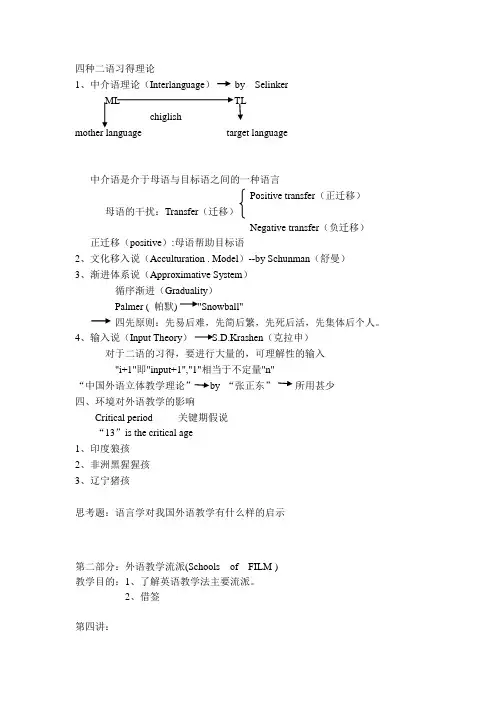
四种二语习得理论1、中介语理论(Interlanguage)by SelinkerML TLchiglishmother language target language中介语是介于母语与目标语之间的一种语言Positive transfer(正迁移)母语的干扰:Transfer(迁移)Negative transfer(负迁移)正迁移(positive):母语帮助目标语2、文化移入说(Acculturation . Model)--by Schunman(舒曼)3、渐进体系说(Approximative System)循序渐进(Graduality)Palmer ( 帕默) "Snowball"四先原则:先易后难,先简后繁,先死后活,先集体后个人。
4、输入说(Input Theory)S.D.Krashen(克拉申)对于二语的习得,要进行大量的,可理解性的输入"i+1"即"input+1","1"相当于不定量"n"“中国外语立体教学理论”by “张正东”所用甚少四、环境对外语教学的影响Critical period 关键期假说“13”is the critical age1、印度狼孩2、非洲黑猩猩孩3、辽宁猪孩思考题:语言学对我国外语教学有什么样的启示第二部分:外语教学流派(Schools of FILM )教学目的:1、了解英语教学法主要流派。
2、借签第四讲:一、FLIM: Foreign Language Teaching Methods(一).GTM(语法翻译法)----Grammar Translation Methods始于18世纪末19世纪中,源于欧洲(西欧),(18世纪前的拉丁语)中国从1872年开始,同文馆标志着中国班级教学的开始。
GTM持续到20世纪70年代。
主要特点如下(弊端)1、重视书面语,轻视口语。

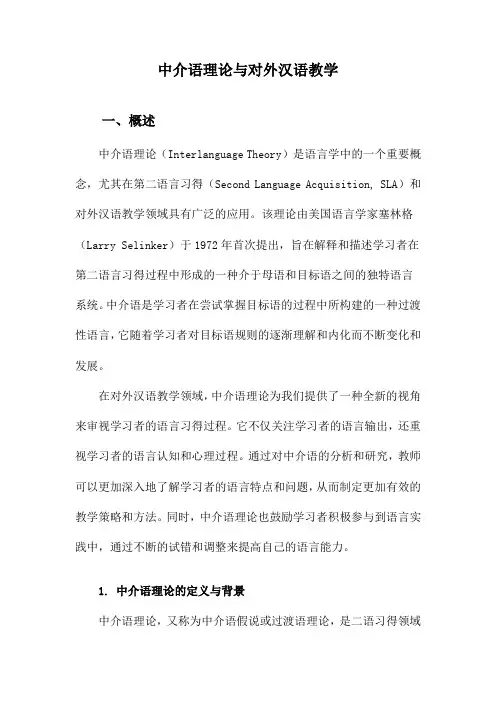
中介语理论与对外汉语教学一、概述中介语理论(Interlanguage Theory)是语言学中的一个重要概念,尤其在第二语言习得(Second Language Acquisition, SLA)和对外汉语教学领域具有广泛的应用。
该理论由美国语言学家塞林格(Larry Selinker)于1972年首次提出,旨在解释和描述学习者在第二语言习得过程中形成的一种介于母语和目标语之间的独特语言系统。
中介语是学习者在尝试掌握目标语的过程中所构建的一种过渡性语言,它随着学习者对目标语规则的逐渐理解和内化而不断变化和发展。
在对外汉语教学领域,中介语理论为我们提供了一种全新的视角来审视学习者的语言习得过程。
它不仅关注学习者的语言输出,还重视学习者的语言认知和心理过程。
通过对中介语的分析和研究,教师可以更加深入地了解学习者的语言特点和问题,从而制定更加有效的教学策略和方法。
同时,中介语理论也鼓励学习者积极参与到语言实践中,通过不断的试错和调整来提高自己的语言能力。
1. 中介语理论的定义与背景中介语理论,又称为中介语假说或过渡语理论,是二语习得领域中的一个核心概念。
该理论由美国语言学家塞林格(Larry Selinker)于1972年首次提出,旨在解释学习者在第二语言习得过程中所产生的一种独特的语言系统。
中介语是学习者母语与目标语之间的一个过渡状态,它既不是母语,也不是目标语,而是一种独立的、动态发展的语言系统。
中介语理论的形成和发展有着深刻的背景。
随着二语习得研究的兴起,研究者开始关注学习者在习得过程中的实际表现,而不仅仅是目标语的语言规则。
随着语言学理论的不断发展,尤其是认知语言学和语用学的兴起,研究者开始关注语言习得的心理过程和认知机制。
随着语言教学实践的不断深入,教师和学习者都意识到,在第二语言学习过程中,学习者会经历一个从不会到会、从不熟练到熟练的过程,而这个过程正是中介语逐步发展和成熟的过程。
中介语理论的核心观点是,第二语言学习者的语言系统是一个介于母语和目标语之间的独立系统,它具有自己独特的语言规则和特点。
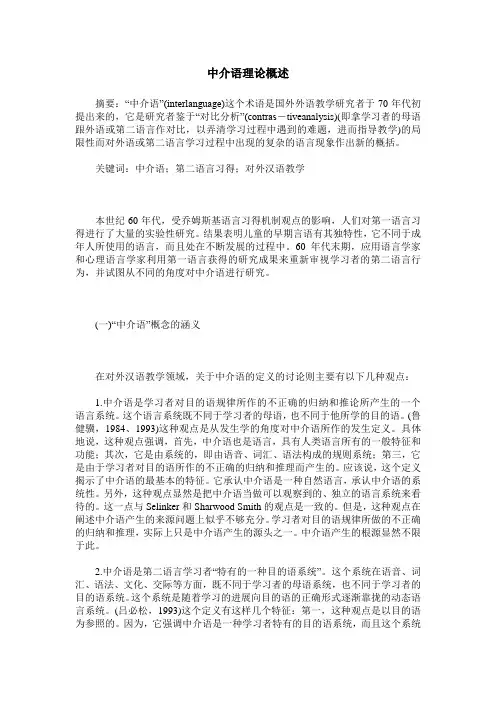
中介语理论概述摘要:“中介语”(interlanguage)这个术语是国外外语教学研究者于70年代初提出来的,它是研究者鉴于“对比分析”(contras-tiveanalysis)(即拿学习者的母语跟外语或第二语言作对比,以弄清学习过程中遇到的难题,进而指导教学)的局限性而对外语或第二语言学习过程中出现的复杂的语言现象作出新的概括。
关键词:中介语;第二语言习得;对外汉语教学本世纪60年代,受乔姆斯基语言习得机制观点的影响,人们对第一语言习得进行了大量的实验性研究。
结果表明儿童的早期言语有其独特性,它不同于成年人所使用的语言,而且处在不断发展的过程中。
60年代末期,应用语言学家和心理语言学家利用第一语言获得的研究成果来重新审视学习者的第二语言行为,并试图从不同的角度对中介语进行研究。
(一)“中介语”概念的涵义在对外汉语教学领域,关于中介语的定义的讨论则主要有以下几种观点:1.中介语是学习者对目的语规律所作的不正确的归纳和推论所产生的一个语言系统。
这个语言系统既不同于学习者的母语,也不同于他所学的目的语。
(鲁健骥,1984、1993)这种观点是从发生学的角度对中介语所作的发生定义。
具体地说,这种观点强调,首先,中介语也是语言,具有人类语言所有的一般特征和功能;其次,它是由系统的,即由语音、词汇、语法构成的规则系统;第三,它是由于学习者对目的语所作的不正确的归纳和推理而产生的。
应该说,这个定义揭示了中介语的最基本的特征。
它承认中介语是一种自然语言,承认中介语的系统性。
另外,这种观点显然是把中介语当做可以观察到的、独立的语言系统来看待的。
这一点与Selinker和Sharwood Smith的观点是一致的。
但是,这种观点在阐述中介语产生的来源问题上似乎不够充分。
学习者对目的语规律所做的不正确的归纳和推理,实际上只是中介语产生的源头之一。
中介语产生的根源显然不限于此。
2.中介语是第二语言学习者“特有的一种目的语系统”。

中介语理论中介语理论中介语理论(InterlanguageKTheory)是由Selinker等人最先提出来的。
所谓中介语是指第二语言学习者建构起来的介于母语和目的语之间的过渡性语言,它处于不断的发展变化过程中,并逐渐向目的语靠近。
Selinker的中介语理论重点强调了第二语言学习中三个方面的问题,①什么样的认知过程负责中介语的建构?②中介语知识系统的性质如何?③为什么多数第二语言学习者不能完全获得目的语的语言能力?KKSelinker认为,负责中介语建构的认知过程有五种,它们是:语言的迁移(language transfer);训练的迁移(transfer of training);第二语言学习的策略;第二语言交际的策略;目的语材料的过度泛化(overgeneralzation)。
Selinker认为,学习者形成的中介语知识系统实际上是一系列心理语法,学习者利用这些语法来解释和产生言语。
这些心理语法是动态的、易于变化的,随着学习的不断深入,中介语知识系统包含了越来越复杂的心理语法。
Selinker认为,在第二语言学习过程存在着语言僵化(fossilization)现象。
它是指某些非目的语的语法、语音等长期存在于中介语中,并且不易改变的现象。
由于存在着语言僵化现象,使得多数学习者不能完全获得目的语的语言能力。
KK中介语理论后来有所的发展,但讨论的问题主要集中在中介语的三个特征方面:①中介语具有可渗透性,即组成中介语的规则并不是固定不变的,它可以受到来自学习者母语和目的语的规则或形式的渗透。
②中介语具有可变性,即中介语是不断变化的,这种变化不是从一个阶段突然跳到下一阶段,而是不断的借助“假设-检验”手段,缓慢地修改已有的规则以适应目的语新规则的过程。
③中介语具有系统性,即中介语是相对独立的语言系统,它具有一套独特的语音、语法和词汇规则体系。
KK中介语理论是较早用认知观点解释第二语言学习的理论模型,其重要意义首先在于它把第二语言学习看作是一种心理过程,并提供了一个理论框架来解释这种心理过程,而且这种理论为后来人们采用实验的方法研究第二语言的学习提供了理论基础。


第三节中介语一、中介语研究概说(一)什么是中介语中介语理论是在认知心理学理论基础上发展起来的。
美国学者L•Selinker于1969年最早提出这一概念,并于1972年在其题为《Interlanguage》的论文中首次使用"Interlanguage"(中介语)这一术语。
中介语是在第二语言习得中产生的,是介于母语和目的语之间的过渡性语言,随着学习者语言知识和交际能力的不断提高,其中介语体系会日趋丰富完善,并逐渐向目的语靠近。
因此从学习过程来说,它同学习活动是密切相关的。
随着学习者水平的提高,低层次的中介语将不断消失,而高层次的中介语将会出现。
它是一动态变化的过程,汉姆莱(Hammerly)曾用图形象地表示出了中介语与目的语之间的关系(1975)如下图所示:从上图可以看出中介语不是两种语言的直接混合,实质上它是不同心理过程与母语和目的语相互作用的结果,是多种因素的"混合"。
Ellis(1994)认为中介语的形成是-个重新创造的过程。
中介语作为一种独立的语言系统有其自身的语言规则(阴影不重合部分),同时它还具有与母语和目的语相似的规则(阴影重合部分)。
学习者的第二语言学习是从零点开始不断向目的话靠近的渐变过程。
它随着第二语言新知识的增加而不断变化。
W•Nemser(l971)把此系统称之为"渐近系统"(approximative systems)。
他认为学习者的这一系统是从零知识(zero knowledge)沿着一连续体(continuum)逐渐接近本族语使用者的语言能力(native speaker competence)。
他认为,"大部分第二语言学习者都处于这一连续体的某一位置,因此中介语不应被看作是静态的、固定不变的,它是处在不断修正,不断向目的语规则接近的过程中的。
"(二)中介语的形成模式及特点1.中介语的产生及形成模式中介语是在第二语言学习过程中的一定阶段才产生的。
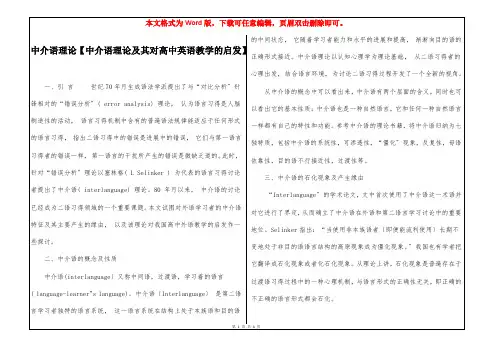
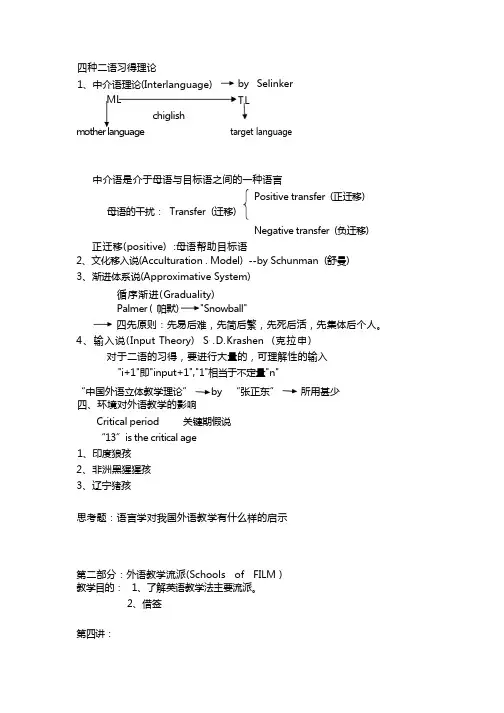
第四讲:四种二语习得理论1、中介语理论(Interlanguage)MLchiglishm other language中介语是介于母语与目标语之间的一种语言Positive transfer (正迁移)母语的干扰: Transfer (迁移)Negative transfer (负迁移)正迁移(positive) :母语帮助目标语2、文化移入说(Acculturation . Model) --by Schunman (舒曼)3、渐进体系说(Approximative System)循序渐进(Graduality)Palmer ( 帕默) "Snowball"四先原则:先易后难,先简后繁,先死后活,先集体后个人。
4、输入说(Input Theory) S .D.Krashen (克拉申)对于二语的习得,要进行大量的,可理解性的输入"i+1"即"input+1","1"相当于不定量"n"“中国外语立体教学理论”by “张正东” 所用甚少 四、环境对外语教学的影响Critical period 关键期假说“13”is the critical age1、印度狼孩2、非洲黑猩猩孩3、辽宁猪孩思考题:语言学对我国外语教学有什么样的启示第二部分:外语教学流派(Schools of FILM )教学目的: 1、了解英语教学法主要流派。
2、借签by Selinker TL target language一、 FLIM: Foreign Language Teaching Methods(一) .GTM (语法翻译法) ----Grammar Translation Methods始于 18 世纪末 19 世纪中,源于欧洲 (西欧), (18 世纪前的拉丁语)中国从 1872 年开始,同文馆标志着中国班级教学的开始。
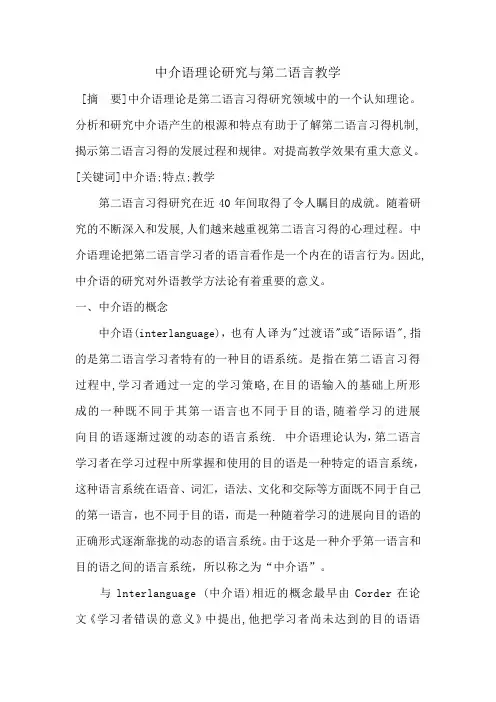
中介语理论研究与第二语言教学[摘要]中介语理论是第二语言习得研究领域中的一个认知理论。
分析和研究中介语产生的根源和特点有助于了解第二语言习得机制,揭示第二语言习得的发展过程和规律。
对提高教学效果有重大意义。
[关键词]中介语;特点;教学第二语言习得研究在近40年间取得了令人瞩目的成就。
随着研究的不断深入和发展,人们越来越重视第二语言习得的心理过程。
中介语理论把第二语言学习者的语言看作是一个内在的语言行为。
因此,中介语的研究对外语教学方法论有着重要的意义。
一、中介语的概念中介语(interlanguage),也有人译为"过渡语"或"语际语",指的是第二语言学习者特有的一种目的语系统。
是指在第二语言习得过程中,学习者通过一定的学习策略,在目的语输入的基础上所形成的一种既不同于其第一语言也不同于目的语,随着学习的进展向目的语逐渐过渡的动态的语言系统. 中介语理论认为,第二语言学习者在学习过程中所掌握和使用的目的语是一种特定的语言系统,这种语言系统在语音、词汇,语法、文化和交际等方面既不同于自己的第一语言,也不同于目的语,而是一种随着学习的进展向目的语的正确形式逐渐靠拢的动态的语言系统。
由于这是一种介乎第一语言和目的语之间的语言系统,所以称之为“中介语”。
与lnterlanguage (中介语)相近的概念最早由Corder在论文《学习者错误的意义》中提出,他把学习者尚未达到的目的语语言能力的外语能力称为过渡能力( transitional competence)。
美国语言学Selinker于1969年在论文《语言迁移》中首先提出中介语假说(interlanguage)的概念。
1971年,W. Nemsers在《外语学习者的相似系统》中提出了“approximative system”的概念。
1972年Selinker在其著名论文《中介语》中提出的中介语假说, 对“中介语”这一概念进行较详细的阐述,是试图探索第二语言习得者在习得过程中的语言系统和习得规律的假说,在第二语言习得的研究史上有重大意义。
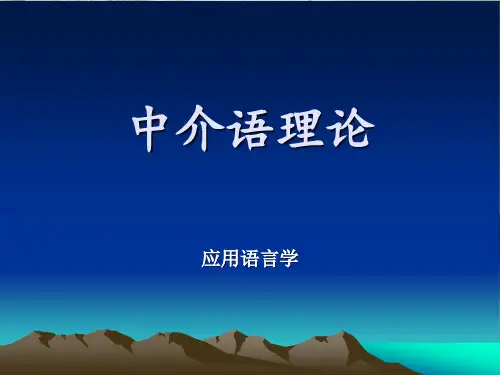
汉语中介语研究的理论思考中介语理论是上世纪70年代初在外语教学学科领域出现的一种新理论,“中介语”(interlanguage)这一概念是由美国学者赛林格(Larry Selinker) 于1972年提出的,中介语理论的产生使70年代的应用语言学研究进入了一个新时代。
我国最早运用中介语理论来研究外国人学汉语的中介语现象的学者是鲁健骥,他在1984年发表的《中介语理论与外国人学习汉语的语音偏误分析》标志着汉语中介语研究的开端。
此后,汉语中介语的研究引起了对外汉语教学界的重视。
至今,汉语中介语的研究已走过了20年的历程。
20年来,汉语中介语研究在引进、消化国外理论的基础上,致力于外国人汉语学习过程中的偏误分析、习得过程和习得顺序研究以及相关理论的研究,取得了长足的进步,对我国的对外汉语教学和学科理论建设做出了巨大的贡献。
但由于我们对这一理论的研究刚刚起步,加之在思维方式上深受西方研究者的影响,未能结合我国的语言现实从更广阔的视角和以开放的视野来观察和研究汉语中介语现象。
本文试着从社会语言学这一视角探讨这一问题,并在此基础上指出现有的汉语中介语研究的局限性,斗胆对此作一些补充。
一、关于中介语的定义我国学者从不同的角度对中介语的定义进行了讨论。
鲁健骥(1984,1993)认为,中介语是学习外语的人在学习过程中对于目的语规律所做的不正确的归纳和推论而产生的一个语言系统。
这个语言系统既不同于学习者的母语,也区别于他所学的目的语。
这种观点是从发生学的角度对中介语所作的发生定义。
这个定义揭示了中介语的最基本的特征。
它承认中介语是一种自然语言,承认中介语的系统性。
吕必松(1993)认为,中介语是指第二语言学习者特有的一种目的语系统,这种语言系统在语音、词汇、语法、文化和交际等方面既不同于学习者的母语,又不同于目的语,而是一种随着学习的进展向目的语的正确形式逐渐靠拢的动态的语言系统。
这种观点将中介语系统扩展到文化和交际的层面。
中介语理论及其在二语教学过程中的应用一、中介语概论中介语( interlanguage)是第二语言习得研究中的一个重要的理论, 这个概念最早是由赛林格在1969年提出的。
在之后的几年里,他又详尽地阐述了中介语的概念, 他在研究中发现在学习第二语言的过程中第二语言学习者会自觉地建立一个既相近于目标语, 却又不同于目标语,也不同于母语的一种语言体系, 从而提出了“中介语〞这一概念。
中介语既可以指第二语言学习者在学习过程中某一特定阶段中认知目标语的方式和结果的特征系统, 也可以指反映所有学习者在第二语言习得整个过程中认知发生和开展的特征性系统。
二、中介语的特性中介语作为一种语言的过渡体系, 有着其自身的特点,笔者以近年来国内外中介语研究结果为依据, 归纳出其特点主要有以下几个方面:1.动态性中介语作为自然语言之一,并不是固定的,而是不断变化的,但是它的变化呈现一种渐变的形式,这种变化不是瞬间改变,而是随着学习者对目标语语言知识和文化知识积累的不断丰富,其语言逐渐向目的语渗透,在这个过程中学习者会不断改变自己的语言系统以向目标语言靠近。
因此也有人把中介语的这个特点称为“渗透性〞。
中介语没有稳定的终极状态, 也没有抵御其他语言, 不受其侵扰的能力。
2.系统性中介语虽然容易受到外界因素的影响而改变,但是改变的倾向也是有规律可循的,这些规那么虽在变化,但也形成了一个有系列性的,不同于目标语也不同于母语的独立语言体系。
以中介语语法为例,中介语语法体系虽然不如第二语言语法体系完善,但是它是一个有着自己的一套独特的语言、语法和词汇规那么的相对独立的过渡语言系统。
如“正迁移〞,“负迁移〞均是由理论指导的。
二语习得者正是按照这套规那么体系,更加自如地运用中介语,而像目标语言逐渐过渡。
如果学习者能早一些发现这个系统的规律,体会到它的系统性,就会以更快,更高效的速率靠近目标语。
3.反复性由于中介语在变化时的形式不是直接的,跳跃的,而是在想目标语靠近时呈现逐渐渗透的形式。
中介语理论[合理利用中介语理论进行外语教学]“中介语”(interlanguage)是英国语言学家Selinker于1969年在其论文“语言迁移”(Language Transfer) 中首次使用。
中介语(interlanguage)理论是在认知心理学的基础发展起来的,它是指外语学习者在学习过程中对目的语规律所做出的归纳和推论而产生的介于目的语与本族语之间的一个动态的不断发展的语言系统。
�布朗(H.D.Brown,1986)从第二语言学习者语言错误类别的角度,将中介语的发展分为:�无规律的错误阶段(random error stage),学生输出的目的语有各种各样的错误,通常都是无规律的、学生对这一阶段的错误解释不清,也纠正不了。
�突生阶段(emergent stage),通过语言学习者的不断学习,输出的目的语逐渐向目的语靠近,语言前后一致,并能运用目的语的某些规则。
但运用的这些规则在目的语的本族语看来,不一定合乎常规。
学生对这一阶段的错误同样无法解释,也无法纠正。
而且学生此时学到的目的语或者称作中介语并不稳定,容易倒退到第一阶段。
�系统形成阶段(systematic stage),由于学习者对目的语的不断学习,有了一定的目的语知识,这一阶段输出地语言更加接近目的语,更加合理,但不是完全正确的。
对于所犯的多数错误,学生能自己更正。
�稳定阶段(stabilization stage),学生已基本掌握目的语系统,能较成功的运用目的语的语言规则。
这时学生就能脱离中介语系统继续学习外语。
�中介语是外语学习者在学习过程中产生的介于目的语与本族语之间的语言系统。
我国的外语教学是在单纯的母语环境中,缺少外语本族语的环境和条件。
我国的目的语学习,中介语的产生是不可避免的。
在学习过程中,学生的错误是各种各样的,以上属于语言形式的错误,即语音、词汇、语法、句法等的错误。
合理利用中介语理论有着极其重要的意义。
�一、正确对待分析处理错误�中介语是一种受规则支配的系统语言,它是运用各种手段对目的语作出各种假设,并在语言接触和交际使用中不断检验假设的学习过程。
中介语⼀、中介语理论的起源20世纪60年代以前,欧美⾏为主义⼼理学和结构主义语⾔学在⼼理学和语⾔学领域占主要地位,在这种理论背景下,语⾔研究领域兴起了对⽐分析理论,对整个外语教学领域有重要的影响。
这种理论认为,外语学习是母语习惯向外语习惯逐步转移的过程。
因此,很多学者和外语教师认为,只要对⽬的语和母语进⾏对⽐,了解母语和⽬的语的异同,就可预测出在⽬的语的学习中会出现什么偏误,⽽且还可以对出现的偏误进⾏分析和解释。
50年代末,⾏为主义⼼理学受到巨⼤冲击,乔姆斯基对语⾔⼼理学的研究是⼈们对外语习得过程中产⽣的偏误有了新的认识。
⼈们发现,外语学习中的偏误并不能完全、准确地⽤对⽐分析的⽅法预测、解释和分析。
后来的许多统计资料也证明了这种猜疑。
这样,以结构主义语⾔学为基础的语⾔对⽐分析受到了⼈们的怀疑。
60年代末,⼀种新的外语学习偏误分析理论产⽣了,这就是中介语理论。
“中介语”⼀词是英国语⾔学家Selinker于1969年在其论⽂“语⾔迁移”(Language Transfer) 中⾸先使⽤。
1972年,他⼜发表的“中介语”(Interlanguage) 的论⽂,对“中介语”这⼀概念进⾏了阐述,确⽴了它在第⼆语⾔习得研究中的地位。
其他研究者们对这⼀概念的描述有许多不同的术语,如W. Nemser (W. Nemser, 1972 ) 称之为“近似语⾔系统”(approximative systems),科德(1967)将它称为“学习者固有的内在的掌握语⾔的课程⼤纲”(learner’s built-in syllabus)、“学习者独有语⾔”(idiosyncratic dialects)、“中继能⼒”(transitional competence)等。
然⽽⼴为⼈知、影响最⼤的还是“中介语”这⼀说法。
⼆、中介语理论的内容中介语(interlanguage)理论是在认知⼼理学的基础发展起来的,它是指由于学习外语的⼈在学习过程中对于⽬的语规律所做出的不正确的归纳和推论⽽产⽣的⼀个语⾔系统。
Interlanguage theoryInterlanguage theory1. Behaviorist learning theoryThe dominant psychological theory of the 1950s and 1960a was behaviorist learning theory. According to this theory, language learning is like any other kind of learning in that it involves habit formation. Habits are formed when learners respond to stimuli in the environment and subsequently have their responses reinforced so that they are remembered. Thus, a habit is a stimulus—response connection. Learning took place when learners had the opportunity to practice making the correct respond to a given stimulus.It should be clear that behaviorist account of L2 acquisition emphasize only what can be directly observed and ignore what goes on in the‘black box’ of the learner’s mind. Learners frequently do not produce output that simply reproduces the input. In short, learning is not just a response to external stimuli.2. A mentalist(精神第一性论者) theory of language learningThe obvious inadequacies of behaviorist explanations of L2 acquisition led researchers to look towards an alternative theoretical framework. From a preoccupation with the role of ‘nurture’(养育) . How environmental factors shape learning), researchers switched their attention to ‘nature’ . how the innate properties of the human mind shape learning). This new paradigm was, therefore, mentalist (or ‘nativist’) in orientation. In the 1960s and 1970s a mentalist theory of first language acquisition emerged. According to this theory:1) Only human beings are capable of learning language.2) The human mind is equipped with a faculty for learning language, referred to as a Language Acquisition Device. This is separate from the faculties responsible for other kinds of cognitive activity.3) This faculty is the primary determinant of language acquisition.4) Input is needed, but only to ‘trigger’ the operation of the language acquisition device.3.What is ‘interlanguage’(中介语)The term ‘interlanguage’was coined by the American linguist, Larry Selinker(拉里●塞林格),in recognition of the fact that L2 learners construct a linguistic system that draws, in part, on the learner’s L1 but is also different from it and also from the target language. A learner’s interlanguage is, therefore, a unique linguistic system.The concept of interlanguage involves the following premises about L2 acquisition;1) The learner constructs a system of abstract linguistic rules which underlies comprehension and production of the L2. This system of rules is viewed as a ‘mental grammar’(精神语法)and is referred to as an ‘interlanguage’.2) The learner’s grammar is permeable(有渗透性的). This is, the grammar is open to influence from the outside . through the input). It is also influenced from the inside. 3) The learner’s grammar is transitional. Learners change their grammar from one time to another by adding rules, deleting rules, and restructuring the whole system. This results in an interlanguage continuum(连续体). This is, learners construct a series of mental grammars or interlanguages as they graduallyincrease the complexity of their L2 knowledge.4) Some researchers have claimed that the systems learners construct contain variable rules. That is, they argue that learners are likely to have competing rules at any one stage development. However, other researchers argue that interlanguage systems are homogeneous(同种的)and that variability reflects the mistakes learners make when they try to use their knowledge to communicate. These researchers see variability as an aspect of performance rather than competence.5) Learners employ various learning strategies to develop their interlanguags. The different kinds of errors learners produce reflect learning strategies.6) The learner’s grammar is likely to fossilize(僵化). Selinker suggested that only about five per cent of learners go on develop the same mental grammar as native speakers. The majority stop some way short. Fossilization dose not occur in L1 acquisition and thus is unique to L2 grammars.4. A computational model(计算模式) of L2 acquisition Figure 1 represents the basic computational metaphor that has grown out of ‘interlanguage’ and that informs much of SLA.The learner is exposed to input, which is processed in two stages. First, parts of it are attended to and take into short-term memory. There are referred to as intake. Second, some of intake is stored in long-term memory as L2 knowledge. The processes responsible for creating intake and L2 knowledge occur within the ‘black box’ of the learner mind where the learner’s interlanguage is constructed. Finally, L2 knowledge is used by the learner to produce spoken and written output . what we have called learner language).input → intake → L2 knowledge → outputFIGURE1 A computational model of L2 acquisition Social aspects of interlanguageRight from the beginning, SLA has also acknowledged the importance of social factors.1. interlanguage as a stylistic continuum(语言连续体)Drawing on work on variability in learner language, Elaine Tarone(伊莱恩●塔龙)has proposed that interlanguage involves a stylistic continuum(语体连续体). She argues that learners develop a capability for using the L2 and that this underlies‘all regular language behaviors’. At one end of the continuum is the careful style(细心语体), evident when learners are consciously attending to their choice of linguistic forms, as when they feel the need to be ‘correct’. At the other end of continuum is the vernacular style(随意语体), evident when learners are making spontaneous choices of linguistic form, as is likely in free conversation.Another theory that also draws on the idea of stylistic variation but which is more obviously social is Howard Giles’s (霍华德●贾尔斯)accommodation theory(调节理论). This seeks explain how a learner’s social group influences the course of L2 acquisition. For Giles the key idea is that of ‘social accommodation’. He suggests that when people interact with each other they either try to make their speech similar to that of their addressee in order to emphasize social cohesiveness (a process of convergence(会聚)) or to make it different in order to emphasize their social distinctiveness(a process of divergence). That is, when the social conditions are such that learners are motivated to converge on (集中于)native-speaker norm. Speak like native speakers) high levels of proficiency ensue, but when the conditions encourage learners to maintain their own social in group less learning takes place. Accordingto Giles’s theory, then, social factors influence interlanguage development via the impact they have on the attitudes that determine the kinds of language use learners engage in.2. The acculturation model(文化适应模式)of L2 acquisitionA similar perspective on the role of social factors in L2 acquisition can be found in John Schumann’s(约翰●舒曼)acculturation model.Schumann investigated on a 33-year-old Spanish (Alberto) who acquired English in the United States. Result of study: Very little evidence of any linguistic development over 10m was found. When learners fail to acculturate to the target-language group, pidginization(洋泾滨化)(they are unable or unwilling to adapt to a new culture) in L2 acquisition is coming into being.The main reason for learners failing to acculturate is social distance—social factors 1) to be socially equal; 2)to assimilate; 3)to share the same social facilities(公共设施). The minor reason is psychological distance(心理距离)—psychological factors1) Language shock(语言休克) 2)motivation.Social factors in acculturation determine the amount of contact with the L2 individual learners experience and determined how successful they are in learning.The problems in acculturation model are Failing to acknowledge the social factors are not fixed and static(静态的)but variable and dynamic and Failing to acknowledge that learners can be both the subject to social conditions and the subject of them. 3.Social identity and investment in L2 learningThe notion of‘subject to’(受……管制)and ‘subject of’(管制……)are central to Bonny Peirce’s(邦尼●皮尔斯)view of the relationship between social context and L2 acquisition. Learning is successful when learners are able to summon up or construct an identity so that they can become the subject of a discourse. If someone felt humiliated in the conversation because he found himself positioned as a ‘strange man’, someone who doesn’t know anything about the discourse. He was subject to a discourse which assumed an identity he doesn’t have.Investment is that something learners will only make if they believe their efforts will increase the value of their‘cultural capital’(文化资本).Peirce’s social theory of L2 acquisition:L2 acquisition=struggle +investment=engage with native speakers + prepare well to challenge Successful learner= reflect critically + construct and assert social identities Discourse aspects of interlanguage1. Acquiring discourse rulesDiscourse rules refer to the rules or regularities in the ways in which native speakers hold conversations.. A: I like your sweater.B: It’s so cold. My sister bought it for me in Italy some times ago.L2 learners behave differently. Sometimes they failed to respond to a compliment all. Like just say: ‘thank you!’More work is needed to demonstrate which aspects are universal and which language specific are as it is already clear that many aspects of leaner discourse are influenced by the rules of discourse in the learner’s L1.2 The role of input and interaction in L2 acquisition1) Different views on input and interactionBehaviorist theory: Input is in the center. Learners acquire language by imitation and habit information.Mentalist theory: Input is just trigger the learner’s SLA. Integrationist(取消隔离)theory: Language acquisition takes place because of both input and learner’s internal mechanism(内在机理).2) The properties of discourseUngrammatical foreign talk: . a. No drive car. b. Mary () doctor c. You give me water. Deletion of some grammatical featuresGrammatical foreign talk: The ice-cream—you will not forget to buy it on your way home—get it when you are coming home.All right At a slower pace, simplified, regularized, and elaborated.Baseline(参照)talk: you won’t forget to buy the ice-cream on your way home, will you Native speakers’style of talking.3) Negotiation of meaning(意义协商)When learners still fail to understand, they pretend to they have understood. This results in interactional modifications at the participation in the discourse.A: so where is DaveB: He vocation.A: He’s on vocation (Confirmation check)B: Yeah. On vocation. (Comprehension check)A: Lucky guy.3. The role of output in L2 acquisitionKrashen argues that ‘speaking is the result of acquisition not its cause’. He claims that the only way learners can learn from their output is by treating it as auto-input(自动输入). In contrast, Merrill Swain(美林●斯温)has argued that output canserve a consciousness-raising function by helping learners to notice gaps in their interlanguages. Second, output can help learners to test hypotheses. Third, learners can talk about their own output, identifying problems with it and discussing ways in which they can be put right.Psycholinguistic(心理语言学)aspects of interlanguage Psycholinguistic is the study of the mental structures(心理结构)and processes involved in the acquisition and use of language.1. L1 transferL1 transfer refers to the influence that the learner’s L1 exerts over the acquisition of L2.The influence is apparent in three ways 1) negative and positive transfer. Negative transfer(负迁移): the learner’s L1 is one of the sources of error in learner language. . drink like an ox vs. drink like fish or bad eggs vs. villains. Positive transfer(正迁移): positive transfer means that the learner’s L1 can facilitate his L2 learning. . Chinese learners of English can learn the sentence following very well: Good morning, Mr. Smith.! Because the logic of “早上好,史密斯先生。